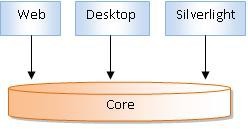Muneswar Rao,
As I mentioned before, all of our products such as Web, Desktop, Silverlight Edition are based on a core DLL which is responsing for rendering map images; that’s what I mean the same algorism for map rendering.

That means Silverlight Edition can render the same effect as web edition does. But the difference is Web Edition is a native server control which can easily modify its properties during Postback while Silverlight can’t by now. You know Silverlight runs on client side and doesn’t postback.
For example, in web edition, you can easily change the color of the label, fill color of the area style by the Postback, while silverlight edition can only get image from the server but can’t modify the server-rendering dynamically. Silverlight Connector can only emulate a Wms server but can’t be changed by t he client stuff for some security problem.
Silverlight Edition has some advantages than web edition such as animations, multi-browse supports, higher performance for client rendering (for example, Silverlight edition can draw countries in the map on the client-side while in web edition, the IE may crash.), More algorism for drawing on client-side, no postback (in silverlight the map doesn’t flash when we you change some properties; while in web edition it flashes without updatepanel.)
“MarkerOverlay can be added to the map control at server-side and can be updated at client-side by accessing the overlay” means we can bind a FeatureSource on server side; just like render the map, we don’t get all the markers from feature source, but get the markers which are available for the viewport only and add into the map. In order to limit the DOM tree node in our web pages to ensure the client performance, whenever the extent changed, we remove all the markers on the client-side --> request the markers in the new viewport asynchronizely --> re-add them into new viewport.
I hope you can know more about these after you read it. If you have more questions please let me know.
Thanks,
Howard
